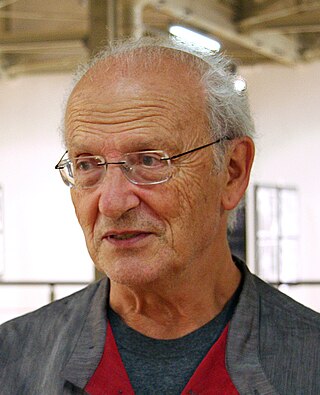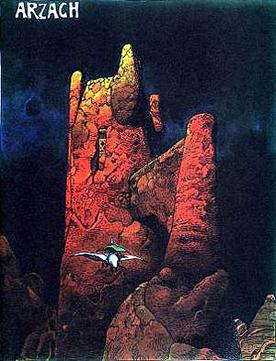
Michael John Moorcock is an English–American writer, particularly of science fiction and fantasy, who has published a number of well-received literary novels as well as comic thrillers, graphic novels and non-fiction. He has worked as an editor and is also a successful musician. He is best known for his novels about the character Elric of Melniboné, which were a seminal influence on the field of fantasy in the 1960s and 1970s.

Heavy Metal was an American science fiction and fantasy comics magazine, published between 1977 and 2023. The magazine was known primarily for its blend of dark fantasy/science fiction, erotica, and steampunk comics.
Bandes dessinées, abbreviated BDs and also referred to as Franco-Belgian comics, are comics that are usually originally in French and created for readership in France and Belgium. These countries have a long tradition in comics, separate from that of English-language comics. Belgium is a mostly bilingual country, and comics originally in Dutch are culturally a part of the world of bandes dessinées, even if the translation from French to Dutch far outweighs the other direction.
Jerry Cornelius is a fictional character created by English author Michael Moorcock. The character is an urban adventurer and an incarnation of the author's Eternal Champion concept. Cornelius is a hipster of ambiguous and occasionally polymorphous gender. Many of the same characters feature in each of several Cornelius books, though the individual books have little connection with one another, having a more metafictional than causal relationship. The first Jerry Cornelius book, The Final Programme, was made into a 1973 film starring Jon Finch and Jenny Runacre. Notting Hill in London features prominently in the stories.

Jean Henri Gaston Giraud was a French artist, cartoonist and writer who worked in the Franco-Belgian bandes dessinées (BD) tradition. Giraud garnered worldwide acclaim predominantly under the pseudonym Mœbius for his fantasy/science-fiction work, and to a slightly lesser extent as Gir, which he used for the Blueberry series and his other Western themed work. Esteemed by Federico Fellini, Stan Lee, and Hayao Miyazaki, among others, he has been described as the most influential bande dessinée artist after Hergé.

Blueberry is a Western comic series created in the Franco-Belgian bandes dessinées (BD) tradition by the Belgian scriptwriter Jean-Michel Charlier and French comics artist Jean "Mœbius" Giraud. It chronicles the adventures of Mike Steve Donovan alias Blueberry on his travels through the American Old West. Blueberry is an atypical western hero; he is not a wandering lawman who brings evil-doers to justice, nor a handsome cowboy who "rides into town, saves the ranch, becomes the new sheriff and marries the schoolmarm". In any situation, he sees what he thinks needs doing, and he does it.

Métal hurlant is a French comics anthology of science fiction and horror comics stories. Originally created in 1974, the anthology ceased publication in 1987, but was revived between 2002 and 2004 in multilingual editions, and then again in 2020.

The Incal is a French graphic novel series written by Alejandro Jodorowsky and originally illustrated by Jean Giraud. The Incal, with first pages originally released as Une aventure de John Difool in Métal hurlant and published by Les Humanoïdes Associés, introduced Jodorowsky's "Jodoverse", a fictional universe in which his science fiction comics take place. It is an epic space opera blending fantastical intergalactic voyage, science, technology, political intrigues, conspiracies, messianism, mysticism, poetry, debauchery, love stories, and satire. The Incal includes and expands the concepts and artwork from the abandoned film project Dune directed by Jodorowsky and designed by Giraud from the early 1970s.

Geofrey "Geof" Darrow is an American comic book artist, best known for his work on comic series Shaolin Cowboy, Hard Boiled and The Big Guy and Rusty the Boy Robot, which was adapted into an animated television series of the same name. He worked as a concept artist and storyboarder for The Matrix series of films. Darrow's approach to comics and art has been cited as an influence by a multitude of artists including Peter Chung, Frank Quitely, Seth Fisher, Eric Powell, Frank Cho, Juan José Ryp, James Stokoe, Chris Burnham, Aaron Kuder, Nick Pitarra,

Jean-Claude Mézières was a French bandes dessinées artist and illustrator. Born in Paris and raised in nearby Saint-Mandé, he was introduced to drawing by his elder brother and influenced by comics artists such as Hergé, Andre Franquin and Morris and later by Jijé and Jack Davis. Educated at the École nationale supérieure des arts appliqués et des métiers d'art, he worked upon graduation as an illustrator for books and magazines as well as in advertising. A lifelong interest in the Wild West led him to travel to the United States in 1965 in search of adventure as a cowboy, an experience that would prove influential on his later work.
Gideon Stargrave is a comics character created by Grant Morrison in 1978 for the anthology comic Near Myths, and later incorporated into their series The Invisibles. The character is based on J. G. Ballard's "The Day of Forever" and Michael Moorcock's Jerry Cornelius, which led to accusations of plagiarism from Moorcock.

Philippe Druillet is a French comics artist and creator, and an innovator in visual design.
Les Humanoïdes Associés is a French-American publishing house specializing in comics and graphic novels, founded in December 1974 by comic artists Mœbius, Jean-Pierre Dionnet, Philippe Druillet, and financial director Bernard Farkas.

Arzach is a comic book collection of four wordless short stories by artist/author Jean 'Moebius' Giraud, which were originally published in the French sci-fi/fantasy comics magazine Métal Hurlant. The stories follow Arzach, a silent warrior who rides a pterodactyl-like creature through a strange, desolate landscape. The imagery and situations in Arzach are often compared to dreams or the subconscious. These stories had an enormous impact on the French comics industry, and the Arzach character is still among Moebius' most famous creations. It can be defined as a pantomime comic, fantasy comics or an experimental comic.
The World of Edena is a series of graphic novels by French artist Jean "Mœbius" Giraud. It grew organically out of a promotional album Mœbius made for the French car manufacturer Citroën, called "The Star", in 1983.

Jean-Marc Lofficier is a French author of books about films and television programs, as well as numerous comics and translations of a number of animation screenplays. He usually collaborates with his wife, Randy Lofficier, and the reason why credits sometimes read "R. J. M. Lofficier", after the initials of both spouses.

Jean-Michel Charlier was a Belgian comics writer. He was a co-founder of the famed Franco-Belgian comics magazine Pilote.

Numa Sadoul (born 7 May 1947, Brazzaville, French Equatorial Africa is a French writer, actor, and director, who has been a resident of France since 1966.
This is a bibliography of the works of Michael Moorcock.
Yacine Elghorri, also referred to as Elgo, is a French illustrator, storyboard artist, conceptual designer and comic book artist. He worked in the United States on films and cartoons such as Matt Groening's Futurama, Titan AE, Evolution directed by Ivan Reitman, Fantastic Four: World's Greatest Heroes, Time Jam: Valerian & Laureline and Thru the Moebius Strip. He has also contributed to the science fiction comics magazine Heavy Metal.













